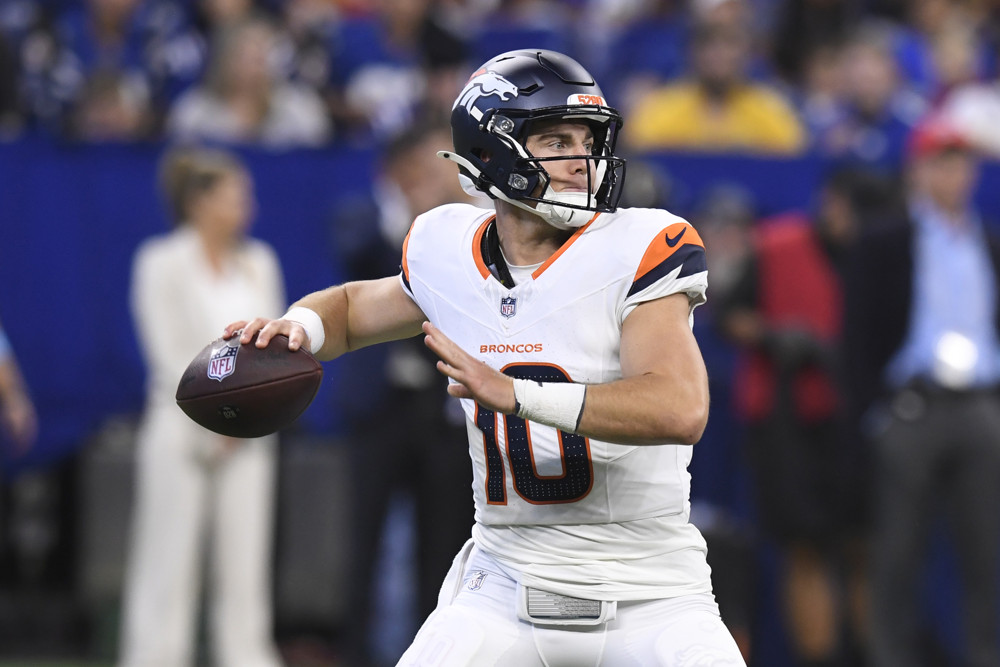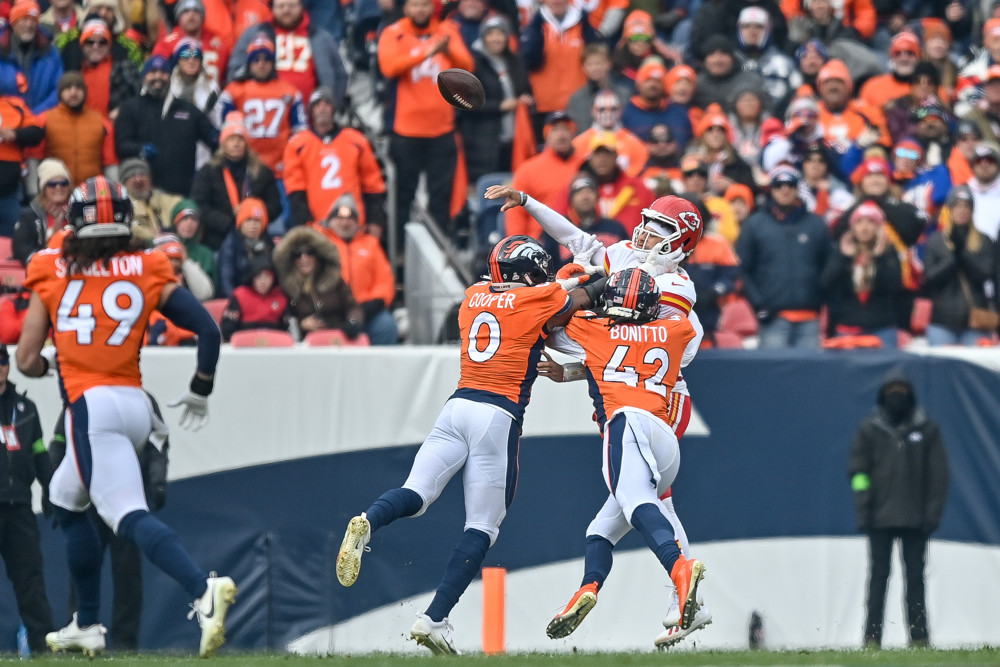
The Denver Broncos Stock Report is back, and it’s better than ever before, despite Sunday’s dismal start to the season.
Understandably, most are turning their eyes forward, toward Week 2, but we’re a little rusty at the stock market, so we’re running a tad behind schedule. These will be coming out earlier in the season before long.
STOCK UP

Denver Broncos Defensive Front
The preseason expectations for the Denver Broncos were that they would have a frisky, promising offense that lifted a shaky defense to a handful of wins. Instead, the inverse might be true, and the Broncos’ young crop of pass rushers is the top reason for the defense’s changed projection.
Against the Seattle Seahawks, the Broncos’ defense produced a pass-rush win rate of 64% and a run-stop win rate of 36%, good for fourth- and sixth-best in the NFL through Week 1. They also generated pressure on 11 of Geno Smith’s 28 dropbacks, good for the ninth-best pressure rate of any defense.
The metrics only get more impressive when drilling down to look at individual performers.
Have a day, Jonathon Cooper! pic.twitter.com/PR1BVBZhGe
— JP Acosta (@acosta32_jp) September 10, 2024
Even among a bevy of standout performers, Jonathon Cooper managed to separate from the pack. ‘Coop’ earned a 50% pass-rush win rate in Week 1, which leads all edge defenders, and a 36% run-stop win rate, which is tied for seventh at the position. Most impressively though, Cooper was so impactful he scored a 26.5 pass-rush productivity (PRP) rating from PFF, which comfortably leads the league. For comparison’s sake, last year, Micah Parsons led the NFL in pass-rush win rate (35%) and PRP (12.4).
The best individual pass rushers at generating pressure in Week 1 💥 https://t.co/AqBDGkQ9eY pic.twitter.com/0boKnG0lFN
— The 33rd Team (@The33rdTeamFB) September 11, 2024
Now, of course, that rate won’t carry throughout the season last year, but it’s hard to deny that Cooper played like an All-Pro on Sunday.
Zach Allen was also a force of nature, generating a pass-rush win rate of 40% on the interior, the second-highest rate in the league at his position, and tallied the sixth-most pressures at his position (4).
Zach Allen forces the safety for the @Broncos! We see you @TheZALLEN44!!! #cthsfb pic.twitter.com/YjSzSPkc2p
— New Canaan Football (@NewCanaanFB) September 8, 2024
Devaughn Vele
As a 26-year-old wide receiver, selected with the 235th pick in the draft, Devaughn Vele has instantly become one of, if not the most dynamic receiving threat on the Denver Broncos.
Why is Devaughn Vele not on your fantasy team right now? pic.twitter.com/i1rvRfiwzy
— ᴄʜᴀsᴇ (@BolieveInNix) September 10, 2024
Anytime a rookie manages to pull that feat off, it’s impressive, but some players — like No. 6 overall pick Malik Nabers or No. 4 overall pick Marvin Harrison Jr. — have an inside track on earning such a role, purely because their draft slot demands they be granted opportunities. Even someone like second-round receiver Ladd McConkey can benefit greatly from this phenomenon.
Meanwhile, Vele didn’t receive any special treatment. He was a projected camp cut from the moment he was drafted up until the second preseason game. He had to scratch and claw his way for every inch, and yet somehow, on Sept. 10, he’s seemingly reached the team’s summit.
Devaughn Vele was the only WR on Next Gen Stats that has a route chart from the Seattle game
— Jordan Lopez (@JordanTLopez) September 9, 2024
He was the only consistent WR for Denver & his routes were all 5 yards or shorter with some quick game concepts they utilized pic.twitter.com/GSNEXMFW4R
Now, that says a lot about the receiving group, but it also says a lot about Vele, who caught everything thrown his way this week. Only Chris Godwin, who also reeled in all eight of his targets, is the only other receiver who could boast a comparable level of reliability this week. Vele was also the most efficient receiver on the team, as he averaged 1.26 yards per route run, slotting him right above Tank Dell and just behind Nabers.
If the Broncos want to rely heavily on quick game, they're going to need more plays like this.
— Joey Richards (@LTB_Joey) September 9, 2024
In this instance, RPO, Nix pulls, and gets it to Vele. Making nothing into 9 yards. pic.twitter.com/ynoWkISMYf
The Broncos need to find a lot of hits like this to help dig themselves out of the talent and capital deficit the Russell Wilson trade put them in. Vele’s early flashes are a big win.
Riley Moss
The Denver Broncos’ enticing young pass rush might be the top reason for improved optimism surrounding the defense, but Riley Moss holding his own and flashing some promise is a strong second-place entry.
Watching Moss in training camp, it was hard to come away with anything other than terror. His preseason performances and regular season performance, so far, make it seem like all that fear was a waste of time.
Riley Moss as nearest defender vs Seattle
— Robby (@Robby_NFL) September 9, 2024
6 receptions on 9 targets for 77 yards on 28 coverage snaps
-1.2 Coverage EPA
3.2 average yards of separation
33% tight windows forced
1.8 YAC per receptions
And for reference, this was the biggest play he allowed. Good coverage just a… pic.twitter.com/izWlq9Jt1y
Now, allowing five of seven targets to be completed for 61 yards isn’t a sterling display in the box score, but his coverage was tighter than those numbers indicate, as a couple of the completions were low-percentage shots.
Riley Moss was SO CLOSE to making a great play and giving Bo Nix the opportunity to go down and get a win in the final drive (also insane catch from Lockett).
— Carter Dillon (@CarterDillon14) September 9, 2024
I really thought Riley looked pretty good on Sunday. Seattle has a talented WR room. It would be great for the Broncos… pic.twitter.com/NPFQXX81zG
Perhaps most promising for Broncos Country, though, was Moss’s tackling, which was a welcome development. Moss allowed just 2.0 yards after the catch, on average — the best mark of any of Denver’s corners.
STOCK DOWN

Bo Nix
Broncos Country, we are going to need nuance when discussing this quarterback.
First, we can all, of course, acknowledge that this is Bo Nix’s first-ever real NFL game. It’s understandable that one might struggle their first time doing something, and beyond that, the sample is far too small to make any sweeping proclamations about what Nix will be throughout his NFL career. We can also all acknowledge that this was a rough setting — a defensive mastermind pulling the strings of a highly compensated defensive line and hyper-athletic secondary, inside a raucous Lumen Field — to make one’s debut in.
Bo Nix threw 12 passes past 10 yards yesterday. 2 of them were intercepted and he threw THREE more (video below) that could've easily been picked.
— Carter Donnick (@CDonnick1) September 9, 2024
Last one is the most egregious. pic.twitter.com/7to9SPR5Gk
That said, we should also be able to acknowledge that Nix’s performance wasn’t ideal and didn’t quite meet pre-game expectations, hence the ‘Stock Down’ placement. The perception of Nix has now declined since we last saw him.
From a yards-per-attempt perspective, it was one of the worst starts by any quarterback since the 1970 merger.
Bo Nix averaged 3.3 yards per attempt on 42 passes today.
— Benjamin Solak (@BenjaminSolak) September 9, 2024
That is tied for the 6th-lowest YPA in any game with at least 40 pass attempts since the merger https://t.co/LIbae0YL6f
From an advanced analytics perspective, it was a generally underwhelming debut, with an EPA/play most comparable to that of Josh Rosen or Bryce Young’s rookie seasons, though, again, it was just one game, whereas those players maintained the stink all year.
His success rate of 28.6% on dropbacks is also shockingly low, to the point that, among last season’s quarterbacks, it most closely resembles Brett Rypien’s one-game stint with the Rams, which instantly resulted in his release.
However, there are also some real nuggets of positivity in the data.
Time to throw was not the issue for Bo Nix. https://t.co/EqGzLdjoXY
— Joe Rowles (@JoRo_NFL) September 11, 2024
First, per PFF, he was pressured more times than everyone but Deshaun Watson and was pressured at a higher rate than everyone but Jacoby Brissett (who had a little more than half of Nix’s dropbacks). When the line actually held up, he looked much more like the expectation of a Bo Nix rookie debut — 19-for-27 for 118 yards (4.3 yards per attempt), and 6.0 yards for his average depth of target, and an adjusted completion percentage just shy of 80%.
Now, that’s pretty low-wattage and also raises some concerns, but those are much more in line with the warts you expect from a rookie premiere. You also need your franchise quarterback to be able to produce when pressured, but again, excusable for a first-ever start.
That feel carries into the performance if you focus on just his targets between 0 and 10 yards of depth, where he had an adjusted completion percentage of 81% on 21 attempts. This is, admittedly, very selective and, as we saw Sunday, something that needs to be expanded to more portions of the field soon, but still, more closely resembles the accurate, decisive QB Broncos Country was sold on.
Nix also delivered on Payton’s desire to mitigate sacks. His 9.1% pressure-to-sack rate trailed only Lamar Jackson, Jordan Love, and the aforementioned Brissett. He also didn’t invite too many pressures, with a quarterback-created pressure rate of 16.7%, which is tied for 17th.
Finally, the tape follows the old adage of, “The film is never as good or as bad as you expect it to be,” but it is still pretty bad.
There are some clear concerns to be had about his performance, but the tape also helps expose some of the coaching, receiving, and line concerns at hand.
Now, again, it’s not time to blare the alarms or declare martial law in the city of Denver. This was one game. Plus, the fact some of the struggles, like the wild inaccuracy and the frantic nature of play, were uncharacteristic of his play, gives hope that this might’ve just not been Bo Nix’s day. The fact he settled in down the stretch, and even led a garbage-time touchdown drive to keep the Broncos alive, helps give the staff something to build off of, and Denver has a good staff to lean on for its quarterback coaching needs.
Nix isn’t the biggest ‘Stock Down’ of the game. He is only the biggest story. The biggest ‘Stock Down’ belongs to the next entry on this list.
Here’s hoping that, with time, we’re able to look back and laugh at this debut and how non-indicative of his career it was, a la John Elway’s ugly first start.
Denver Broncos Pass Catchers
Bo Nix didn’t cover himself in glory, but the Denver Broncos’ assortment of pass-catchers didn’t do him any favors.
Throughout the game the receivers struggled to get off the line and into their routes, disrupting the timing of the offense and helping feed Nix’s uncertainty about what he was seeing and where to go with the football.
The Broncos’ receivers also struggled to haul in the passes when they were targeted, boasting a drop rate of 7.1%. In the small sample size of Week 1, that ranks just 14th, but, when compared to the normalized season-long numbers of 2023, we can see that only four quarterbacks suffered a higher rate of dropped passes last season.
Plus, once they had the football, they were equally ineffective, as the 43 yards after catch (YAC) Denver tallied between its wide receivers and tight ends ranked 21st in the league.
2- Seattle's secondary tackled extremely well in open field, most notably Julian Love, Devon Witherspoon, and K'Von Wallace. Veteran Rayshawn Jenkins added 6 tackles as the Seahawks kept Bo Nix & the Broncos out of the EZ for 58 minutes.#Seahawks #SeattleSeahawks pic.twitter.com/b3yQ9CAkJO
— All 22 Films (@All_22_NFL_Cuts) September 11, 2024
As a whole, the unit looked slow, lacked dynamism, and didn’t seem at all like it was built to complement Nix’s strengths (which, it wasn’t, but it would be nice to feel like an attempt was made).
Dialing up the intensity of those issues is the fact that the most explosive receiver on the market right now is likely former Jaguars return specialist Jamal Agnew, meaning the Broncos desperately need someone on-roster to step up.
Devaughn Vele has already begun to step up, but the two players best equipped to cure Denver’s woes are Troy Franklin and Marvin Mims, and both are coming off suspect summers. Mims played deep into his preseason showings, while Franklin played late into the preseason games, faced dubious camp reports, and was a healthy scratch for Week 1. Those young speedsters need to reverse course ASAP to feel confident about this offense finding its footing.
Sean Payton and the rest of the Denver Broncos’ offensive staff
A lot of the offseason optimism surrounding Bo Nix and this Denver Broncos offense came back to the man at the helm — Sean Payton — and the cast of well-respected, heavily experienced offensive minds he surrounded himself with.
A mere four days ago, the media was complimenting Payton and Davis Webb for working hard to expedite Nix’s professional development, and three months ago the media was saying Webb would be an NFL head coach in no time.
Yet, once the live bullets started firing in regular season action, the Broncos’ offensive staff looked beyond ill-prepared to pivot.
The Seattle Seahawks entered the game understanding what Denver wanted to do on offense, and they snuffed it out almost instantaneously. The troubling part was how the Broncos’ coaches seemed incapable of devising a counter-punch.
Even if Denver had caught Seattle’s defense off-guard, and ran away with a successful and promising offensive showing, the Pittsburgh Steelers would come into Week 2 with some preparation to attack that game plan, so Payton’s staff would likely have had to demonstrate some ability to pivot early on, no matter what.
The need for a counter-punch was easily predictable, and Denver’s staff was left looking like the high school kid who forgot all about the summer reading assignment come the first day of class.
$20 million, a first-round pick, and a second-round pick should buy you a better coaching display than that.
Offensive Line
This was not a typical performance from Quinn Meinerz and the rest of the Denver Broncos offensive line.
The aforementioned pressure stats reflect poorly on the entire line, as does the team’s complete inability to run the football.
Most disappointing of all though, in his first game after signing a big extension, Meinerz might have been the weakest part of the line. Meinerz and fellow highly paid guard Ben Powers combined to allow seven pressures on Sunday, tied for the most of any guard tandem in the league, and enough to make them the only guard tandem to have each player allow at least three pressures in Week 1.
Leonard Williams was an absolute menace on Sunday. Makes Quinn Meinerz look terrible slanting inside here, blasts Bo Nix as he throws on pass Julian Love picks off at goal line. #Seahawks pic.twitter.com/STR4nWuPjA
— Corbin K. Smith (@CorbinSmithNFL) September 10, 2024
Garett Bolles also had a disappointing game. On 33.3% of dropbacks, Bolles was charted as bearing ‘some responsibility’ for allowing a pressure, tied for the sixth-worst rate in the league among all left tackles in Week 1. Last season, Bolles bore responsibility for allowing pressure on just 14.7% of dropbacks, which was the fourth-best mark in the league, and that was with a quarterback who was much more difficult to block for.
